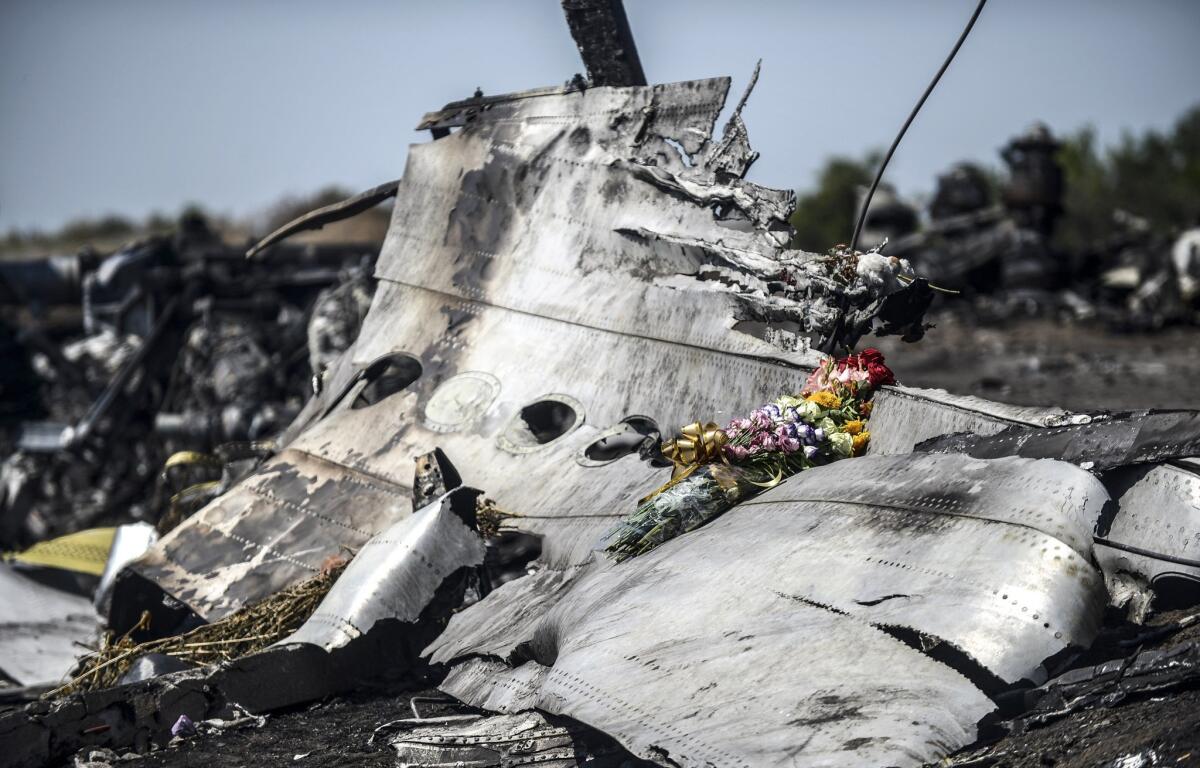Investigators say Malaysian jet was downed over Ukraine by a Russian missile

- Share via
Reporting from NIEUWEGEIN, Netherlands — Dutch-led criminal investigators said Wednesday that they had solid evidence that a Malaysian jetliner was shot down in 2014 by a Russian-made Buk missile that was moved into eastern Ukraine from Russia.
Wilbert Paulissen, head of the Central Crime Investigation department of the Dutch National Police, said communications intercepts showed that pro-Moscow rebels had called for deployment of the mobile surface-to-air weapon and reported its arrival on July 17, 2014, in rebel-controlled territory in eastern Ukraine.
The missile was launched the same day from farmland in the rebel-held area of Pervomaiskiy, three miles from the eastern Ukrainian town of Snizhne, the investigation found. Malaysia Airlines Flight 17 was blasted out of the sky from an altitude of 33,000 feet, killing all 298 people aboard,
Witnesses there reported an explosion and a whistling sound and a patch of field was set on fire.
From that and other evidence collected by investigators, “it may be concluded MH17 was shot down by a 9M38 missile launched by a Buk, brought in from the territory of the Russian Federation, and that after launch was subsequently returned to the Russian Federation,” Paulissen said at a news conference Wednesday in the Dutch town of Nieuwegein.
The conclusions of the investigative unit — which includes police and prosecutors from the Netherlands, Ukraine, Belgium, Australia and Malaysia — were consistent with previous reporting by the Associated Press, which established soon after Flight 17’s destruction that a tracked Buk M-1 launcher with four SA-11 surface-to-air missiles had been sighted the same day in the rebel-controlled town of Snizhne near Pervomaiskiy.
A separate investigation by Dutch officials last year concluded that the Amsterdam-to-Kuala Lumpur flight was downed by a Buk missile fired from territory in Ukraine held by pro-Russia rebels.
Dutch police spokesman Thomas Aling said the joint investigation findings differ in that they are designed to be solid enough to be used as evidence in a criminal trial. Where and when a trial might take place are still to be determined, Aling said.
“The next question, of course, is who was responsible for this,” Dutch chief prosecutor Fred Westerbeke said. He said investigators have identified 100 people they want to speak to who are believed to have been involved in the transport of the Buk launcher or its use.
Moscow officials have consistently denied allegations that pro-Kremlin rebels in eastern Ukraine were responsible for downing the passenger plane. The Russian Foreign Ministry reacted quickly to the release of the international investigation’s findings, calling the inquiry “biased and politically motivated.”
See the most-read stories in World News this hour »
Russian Foreign Ministry spokeswoman Maria Zakharova also said the Dutch-led investigation has ignored evidence offered by Russia and allowed Ukraine to manipulate the evidence and shape anti-Russian conclusions.
On Monday, the Russian military said it has new radio-location data that showed the missile that downed the Boeing 777 did not originate from rebel-controlled territory, and said it would turn that data over to investigators.
Ukrainian officials countered that the Dutch-led team’s findings prove Russia’s complicity in the tragedy.
“A new and very important element in today’s report is the information about the route by which the weapon came from Russia to Ukraine and was removed in the opposite direction through part of the Ukrainian-Russian border that was controlled only by Russia and their militants,” Ukraine’s Foreign Ministry said in a statement. “This again points to the direct involvement of the aggressor state in the downing of the aircraft.”
The Russian maker of the Buk air defense missile system also contested the conclusions of the investigation.
Mikhail Malyshevsky, an advisor to the director of the state-controlled Almaz-Antey consortium, said Wednesday that an analysis of the plane’s shrapnel-ridden fragments showed that it couldn’t have been downed by a missile launched from a rebel-controlled area in eastern Ukraine.
He said the missile probably came from an area that Russian officials have previously described as Ukraine-controlled.
The Joint Investigation Team has faced extraordinary challenges. The site in Ukraine’s Donetsk region where the plane was brought down was in an active war zone. In the days after the downing, pro-Kremlin militants limited access to the crash site.
Eleven containers crammed with debris from the jetliner were brought to the Netherlands. A research team took soil samples in eastern Ukraine and established the location of cellphone towers and the layout of the local telephone network to verify intercepted phone calls from the militants.
Forensic samples were taken from passengers’ and crew members’ bodies and luggage, and satellite data and communications intercepts were scrutinized. The team also appealed for information from witnesses who may have seen the missile launch.
About two-thirds of the passengers aboard the flight were Dutch nationals; the crew members were Malaysians. Malaysia proposed setting up an international tribunal to try those responsible for the plane’s destruction, but Russia vetoed a United Nations Security Council resolution in favor of a tribunal.
ALSO
As drought grips Iran, farmers lament loss of a way of life
Shimon Peres, Israeli leader instrumental in peace process, dies at 93
What people around the world thought of the first U.S. presidential debate
UPDATES:
9:15 a.m.: This article has been updated with additional details.
8:15 a.m.: This article was updated throughout with new details.
This article was originally published at 4:40 a.m.
More to Read
Sign up for Essential California
The most important California stories and recommendations in your inbox every morning.
You may occasionally receive promotional content from the Los Angeles Times.










